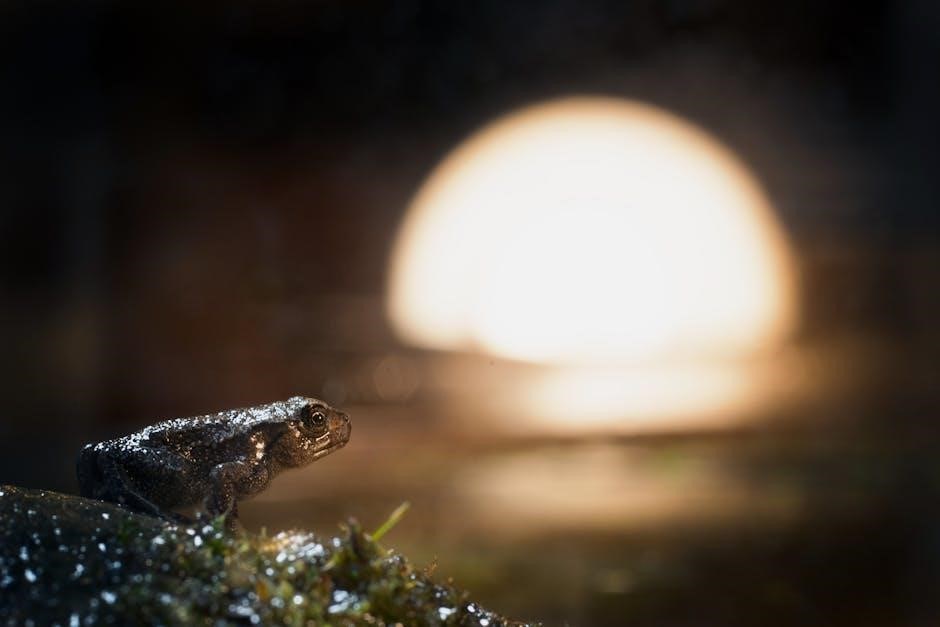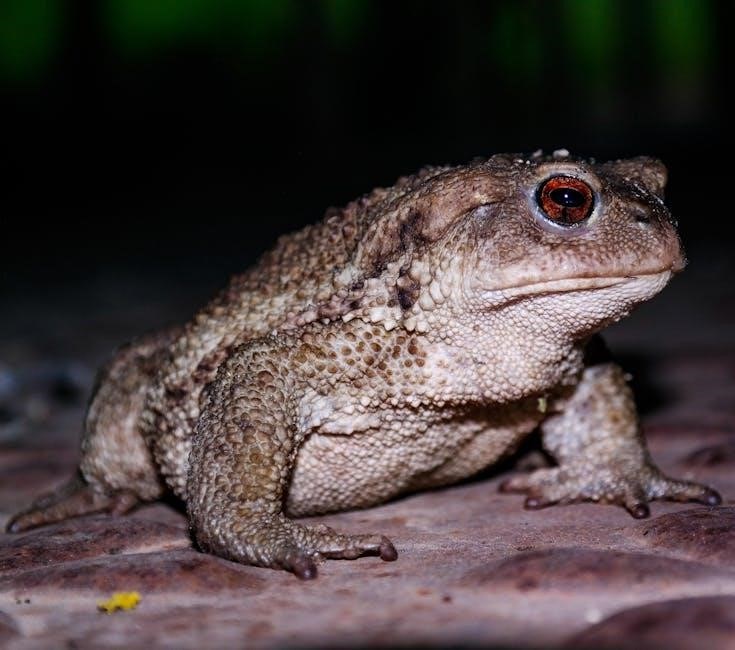The story revolves around Ben Moroney, a young boy who moves to Massachusetts, exploring his connection to spadefoot toads and their unique mating cycle.

1.1 Overview of the Book
Night of the Spadefoot Toads is a captivating story by Bill Lattimer that follows the journey of Ben Moroney, a young boy who moves to Massachusetts with his family. The story explores Ben’s adaptation to his new home, his curiosity about nature, and his fascination with spadefoot toads. These unique amphibians, which emerge only during specific rainy nights, become a central focus for Ben as he learns about their life cycle and the importance of conservation. The book blends elements of adventure, friendship, and environmental awareness, making it an engaging read for children and adults alike. It also highlights the significance of connecting with nature and understanding the delicate balance of ecosystems.
1.2 Background Information
Night of the Spadefoot Toads is set in Massachusetts, where Ben Moroney, a young boy, navigates a new home and friendships. The story highlights his fascination with spadefoot toads, which emerge only during specific rainy nights to mate in temporary vernal pools. This unique biological phenomenon sparks Ben’s curiosity about nature and conservation. The book explores themes of adaptation, environmental stewardship, and the importance of human connection with wildlife. By focusing on the spadefoot toads’ brief but critical mating period, the story underscores the fragility of ecosystems and the role individuals can play in protecting them. The narrative blends science, adventure, and emotional growth, making it both educational and engaging for readers of all ages.
1.3 Cultural Significance
Night of the Spadefoot Toads holds cultural significance by fostering a deeper appreciation for nature and conservation. The story highlights the importance of environmental stewardship, resonating with contemporary concerns about biodiversity and ecosystem preservation. It also bridges generations, showing how adults and children can form meaningful connections through shared interests in wildlife. The book’s focus on spadefoot toads, often overlooked creatures, raises awareness about their unique life cycle and the fragility of their habitats. By blending education with storytelling, it inspires readers to take action in protecting their local environments. This cultural impact lies in its ability to educate and motivate, making it a valuable resource for both personal and community growth.
Main Characters
Ben Moroney, a young boy who moves from Tucson to Massachusetts, is the protagonist. His curiosity and determination drive the story, focusing on his connection to spadefoot toads.
2.1 Ben Moroney
Ben Moroney is the protagonist, a young boy who relocates from Tucson, Arizona, to Massachusetts with his family. The move sparks a sense of loss as he leaves behind his best friend, Tony, and his beloved pet, a western banded gecko named Lenny. In his new environment, Ben struggles to adjust, missing the familiar desert landscape. However, his curiosity and passion for nature lead him to discover the spadefoot toads, forming a unique connection. His interest in these creatures drives the narrative, showcasing his resilience and adaptability in the face of change. Ben’s journey highlights themes of friendship, conservation, and personal growth.
2.2 Supporting Characters
The story introduces several supporting characters who play pivotal roles in Ben’s journey. His science teacher, Tibbets, sparks his interest in spadefoot toads and encourages his curiosity. Tony, Ben’s best friend from Tucson, remains a significant figure in his life despite the distance. Additionally, the community in Massachusetts, including classmates and neighbors, contributes to Ben’s adjustment. These characters highlight the importance of friendship, mentorship, and shared experiences in shaping Ben’s understanding of the world and his connection to nature. Their interactions with Ben emphasize themes of support and collaboration, enriching the narrative and his personal growth.

Setting
The story unfolds in Massachusetts, where Ben moves from Tucson, Arizona. The vernal pools and temporary wetlands are crucial for the spadefoot toads’ brief mating season.
3.1 Geographic Location
The story is set in Massachusetts, where Ben Moroney moves with his family. The narrative highlights the transition from his previous home in Tucson, Arizona, to a new environment. Massachusetts provides a unique backdrop with its vernal pools, which are essential for the spadefoot toads’ mating and breeding. These temporary wetlands are crucial for the toads’ survival, as they rely on the brief presence of water to complete their life cycle. The geographic location emphasizes the contrast between the arid desert of Arizona and the lush, seasonal habitats of Massachusetts, showcasing how the environment plays a pivotal role in shaping the story and its ecological themes.

3.2 Importance of the Environment
The environment plays a central role in shaping the narrative, particularly through the vernal pools where spadefoot toads breed. These temporary wetlands are essential for the toads’ survival, as they rely on the brief presence of water to mate and lay eggs. The story highlights the delicate balance of ecosystems and the impact of human activities on wildlife habitats. Massachusetts’ seasonal climate and unique geography create a backdrop that underscores the importance of conservation and environmental stewardship. The environment not only drives the plot but also serves as a character in itself, influencing Ben’s journey and his connection to the natural world. This emphasis on ecological themes makes the story a powerful tool for environmental education and awareness.

Plot Summary
The story follows Ben as he navigates a new home, discovers spadefoot toads, learns about their unique mating cycle, and explores environmental themes and personal growth.
4.1 Chapter Highlights
The story begins with Ben Moroney adjusting to his new life in Massachusetts, far from his Arizona home. Early chapters focus on his loneliness and curiosity about the natural world around him. A pivotal moment occurs when Ben discovers spadefoot toads during a rainy night, sparking his fascination with their unique life cycle. Subsequent chapters explore his efforts to protect their habitat and learn about conservation. The narrative weaves together Ben’s personal growth, friendships, and environmental awareness, highlighting the importance of small actions in making a difference. Each chapter builds on themes of connection, responsibility, and the beauty of nature.
4.2 Climax and Resolution
The climax unfolds during a heavy rainstorm, where Ben and his friends race against time to protect the spadefoot toads’ breeding habitat from destruction. Their efforts are tested as they face challenges like flooded roads and time constraints. In a tense moment, they successfully create a safe environment for the toads to mate, ensuring the survival of their species. The resolution brings a sense of accomplishment as Ben reflects on the impact of their actions. The story concludes with a hopeful message about the power of small actions and the importance of preserving nature, leaving readers inspired to take part in conservation efforts.

Themes
The story explores themes of conservation, highlighting the importance of protecting spadefoot toads and their habitats. It also emphasizes friendship and personal growth, showcasing how connections and challenges shape Ben’s journey.
5.1 Conservation and Ecology
The story highlights the importance of conservation through Ben’s dedication to spadefoot toads. These amphibians depend on vernal pools, temporary ecosystems threatened by human activities. Ben learns about their unique mating cycle, which occurs only once a year, emphasizing the fragility of their existence. The narrative underscores the need to protect these habitats and raises awareness about the impact of environmental changes. By focusing on the toads’ plight, the book encourages readers to consider humanity’s role in preserving biodiversity. The themes of conservation and ecology are woven throughout the story, inspiring both children and adults to take action in safeguarding nature.
5.2 Friendship and Connection
The story emphasizes the power of friendship and human connection through Ben’s relationships. Moving to a new town, Ben feels isolated but finds common ground with others through his passion for spadefoot toads. His bond with his science teacher and classmates illustrates how shared interests can bridge gaps. The narrative shows how friendships can provide support during life transitions, fostering empathy and understanding. Ben’s journey highlights that connections, whether with people or nature, are vital for personal growth and overcoming challenges. This theme encourages readers to value relationships and collaborate in making a positive impact on their communities and the environment.
5.3 Life Changes and Adaptation
Ben’s journey in “Night of the Spadefoot Toads” reflects the challenges of adapting to life changes. His move to Massachusetts forces him to leave behind familiar surroundings and friends, mirroring the spadefoot toads’ adaptability to their ephemeral habitats. The story highlights how change, though difficult, fosters growth and resilience. Ben’s experiences teach him to embrace new environments and connect with others, much like the toads’ brief yet vital mating period. This theme underscores the importance of flexibility and the ability to thrive in unfamiliar circumstances, both for humans and wildlife.

Educational Value
The book offers quizzes and activities that enhance learning about spadefoot toads, their biology, and conservation, making science engaging and fostering critical thinking in young readers.
6.1 Learning About Spadefoot Toads

The story educates readers about spadefoot toads’ unique life cycle, their dependence on vernal pools, and their adaptation to survive in diverse environments. It highlights their nocturnal behavior, burrowing habits, and the importance of conservation efforts to protect these amphibians. The book also introduces the concept of ecological balance and the impact of human actions on wildlife. Through Ben’s journey, students gain a deeper understanding of these fascinating creatures and the significance of their role in the ecosystem. This learning experience fosters curiosity and encourages young readers to engage in environmental stewardship.
6.2 Science and Nature Education
The book seamlessly integrates science and nature education by exploring ecological concepts through Ben’s experiences. It highlights the importance of vernal pools and their role in supporting spadefoot toads, teaching students about habitats, adaptation, and the water cycle. The story encourages critical thinking about human impact on the environment and promotes scientific inquiry. Interactive elements, such as quizzes and activities, engage young learners, making complex concepts accessible. By connecting science to real-world observations, the book fosters a deeper appreciation for nature and inspires students to explore the natural world around them. This educational approach makes science relatable and fun, encouraging lifelong learning and environmental stewardship.
The Spadefoot Toads
Spadefoot toads are unique amphibians known for their spade-like digging tools and brief breeding cycles tied to seasonal rains, making them fascinating subjects in ecological studies and conservation efforts.
7.1 Biology and Behavior
Spadefoot toads are nocturnal amphibians, spending most of their time in underground burrows. They emerge at night to forage for insects, showcasing their adaptation to arid environments. Their diet consists mainly of small invertebrates, which they capture using their sticky tongues. Spadefoot toads exhibit unique breeding behavior, relying on seasonal rains to create temporary pools for mating. Males produce distinctive calls to attract females, and eggs hatch quickly to make the most of the brief water availability. Their life cycle is adapted to survive in areas with limited water, making them resilient to drought conditions. This unique biology underscores their ecological importance in their native habitats;
7.2 Habitat and Life Cycle
Spadefoot toads thrive in temporary habitats, such as vernal pools and dry, sandy areas. Their life cycle begins with eggs laid in rain-filled pools, hatching into tadpoles within days. The tadpoles develop rapidly, metamorphosing into juvenile toads within weeks. Adults burrow into soil during dry periods, surviving on stored water. This adaptation allows them to withstand arid environments. Their habitat preferences and life cycle are tightly linked to seasonal rains, ensuring the survival of their species in ecosystems with limited water availability. The reliance on temporary pools highlights their ecological dependence on specific environmental conditions.
7.3 Conservation Status
Spadefoot toads face threats such as habitat loss, disease, and climate change, which disrupt their breeding cycles. Conservation efforts focus on protecting their habitats, particularly vernal pools. Educational programs raise awareness about their ecological importance. Protecting these environments ensures the survival of spadefoot toads and maintains biodiversity in ecosystems they inhabit.
PDF Resource
The PDF version of Night of the Spadefoot Toads is readily available online, offering convenient access to the story and its educational content for readers worldwide.
8.1 Availability and Access
The PDF version of Night of the Spadefoot Toads is widely available online, ensuring easy access for readers. Platforms like Quizizz and Wayground offer free downloads, making it convenient for students and educators to utilize the resource. The digital format allows for effortless sharing and distribution, catering to both individual readers and classroom settings. Its availability has been highlighted in various educational forums and websites, particularly since 2021, when its popularity surged among teachers for science and nature-based curricula. This accessibility ensures that the story and its educational content can reach a broad audience, promoting learning about spadefoot toads and their unique life cycle.
8.2 Benefits of the PDF Version
The PDF version of Night of the Spadefoot Toads offers numerous benefits, enhancing both accessibility and engagement. Its digital format allows for easy storage on devices, making it portable and convenient for reading anywhere. The PDF preserves the book’s original layout, ensuring that illustrations and text remain crisp and clear. Additionally, it enables quick navigation through chapters and sections, aiding in study and reference. Features like search functionality and zoom options further improve the reading experience. Educators can easily share the PDF with students, facilitating group discussions and assignments. Overall, the PDF version is a versatile and practical choice for readers seeking a modern, efficient way to enjoy and learn from the story about spadefoot toads.

Quizzes and Activities
Engage with quizzes and activities that deepen understanding of the spadefoot toads’ story, fostering learning and fun through interactive challenges and educational games for all ages.
9.1 Night of the Spadefoot Toads Quiz
The Night of the Spadefoot Toads quiz is designed for 4th-grade students, covering chapters 1-6. It tests comprehension of key events, characters, and themes, such as Ben’s journey, the spadefoot toads’ unique life cycle, and conservation efforts. The quiz includes multiple-choice questions, true/false statements, and short-answer sections to engage students. Available on platforms like Quizizz, it encourages interactive learning and reinforces the story’s educational value. Perfect for classrooms or individual study, the quiz helps students connect with the narrative while assessing their understanding of ecological and friendship themes. Its fun format makes learning enjoyable and impactful for young readers.
9.2 Educational Games and Puzzles
Educational games and puzzles complement the learning experience of Night of the Spadefoot Toads. Interactive activities, such as quizzes, crosswords, and matching games, engage students in a fun and dynamic way. These resources, available online, help reinforce key concepts like conservation, friendship, and adaptation. Puzzles focus on the spadefoot toads’ biology and habitat, encouraging students to think critically. Games like “Toad Trivia” and “Vernal Pool Adventure” make learning enjoyable while enhancing comprehension. These tools are designed to be both entertaining and educational, ensuring students stay engaged and develop a deeper appreciation for the story’s themes and ecological lessons.
The story of Night of the Spadefoot Toads offers a compelling blend of adventure, friendship, and environmental awareness, inspiring readers to appreciate nature and its fragile beauty.
10.1 Final Thoughts
Night of the Spadefoot Toads leaves readers with a profound appreciation for nature and the importance of conservation. Ben Moroney’s journey highlights the power of friendship and growth, showcasing how meaningful connections can emerge in unexpected places. The story underscores the fragile balance of ecosystems and the role individuals play in protecting them. By blending adventure with environmental themes, the book inspires readers to take action and cherish the natural world. The unique plight of the spadefoot toads serves as a reminder of the beauty and complexity of life. This charming tale lingers in the mind, urging readers to explore and preserve the world around them.
10.2 Encouragement to Read
Night of the Spadefoot Toads is a captivating tale that blends adventure, friendship, and environmental themes, making it a must-read for all ages. The story’s unique focus on spadefoot toads and their fascinating life cycle offers readers a chance to learn about these intriguing creatures while being immersed in a heartfelt narrative. Ben Moroney’s journey from feeling isolated to finding purpose through conservation is both relatable and inspiring; The book’s ability to balance education with entertainment ensures that readers will not only enjoy the story but also gain a deeper appreciation for nature. With its uplifting message and engaging characters, this book is a delightful addition to any reader’s collection, encouraging them to explore and protect the natural world.

Additional Resources
Explore online quizzes, related books, and educational articles for deeper insights into spadefoot toads and their fascinating world.
11.1 Related Books and Articles
Discover more about spadefoot toads through related books like “Slippery Creatures” and articles on amphibian conservation. These resources offer insights into their biology and ecological importance, complementing the story’s themes. Online platforms like Quizizz provide educational quizzes, while articles from environmental organizations detail conservation efforts. Books such as “Everything You Need to Know About Frogs” add depth to the learning experience. Explore these materials to enhance your understanding of spadefoot toads and their unique role in nature.
11.2 Online Communities and Forums
Engage with online forums and communities to deepen your understanding of spadefoot toads. Websites like Wayground and Quizizz offer interactive quizzes and educational resources. Environmental forums discuss conservation efforts and amphibian ecology. Join Facebook groups or Reddit threads dedicated to wildlife enthusiasts to share insights and learn from experts. These platforms foster collaboration and provide access to firsthand experiences. For educators, online communities offer lesson plans and activities tailored for students. Explore these digital spaces to connect with others passionate about spadefoot toads and their habitats. Online discussions often highlight the latest research and advocacy initiatives, making them invaluable for both learning and engagement.
Leave a Reply
You must be logged in to post a comment.